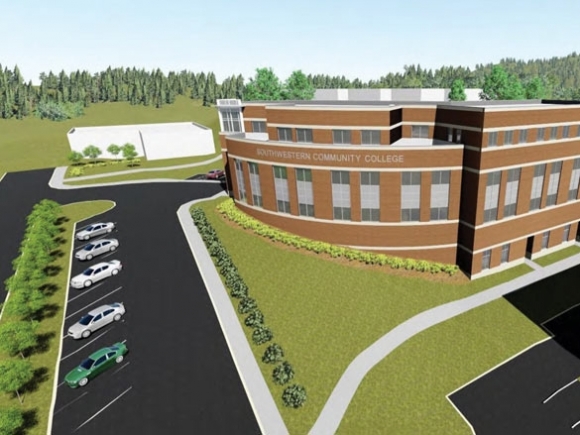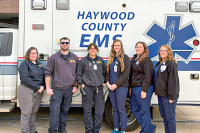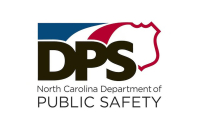Lopsided allocation favors SCC project over Jackson County Schools

Jackson County Schools has found itself at the back of the line to get a piece of the quarter-cent sales tax voters passed last year.
Jackson voters approved a quarter-cent sales tax last May on the premise it would go to the public school system and Southwestern Community College for capital projects.
But the school system won’t see a dime of the sales tax money for four years, according to the latest county budget proposal. Instead, all the sales tax money for the next four years will go to SCC for a new $20 million health sciences building.
SCC will continue to get the majority of the sales tax money for another four years before the school system finally gets an equal share.
County commissioners are ultimately the ones to decide how the quarter-cent sales tax money is divvied up. They expressed concern during a budget workshop last week over the funding plan that favors SCC in the near term.
“I have been one of the biggest advocates of saying ‘Let’s not take all of our sales tax monies away from the schools,’” said Commissioner Mickey Luker. “I don’t want the taxpayers, the mothers, the parents, to come and say ‘This board was not working in the best interest of our school system.’”
Related Items
Commissioner Boyce Dietz agreed he didn’t want to “cut them short.”
However, county commissioners feel like they have no choice but to fund the SCC health sciences building, even if it means the schools have to wait several years for their share of the sales tax money.
The health sciences building was touted publicly as part-and-parcel to the quarter-cent sale tax. It appeared on brochures, posters and Power Points as a shining example of what the quarter-cent sales tax would be used for if passed.
Meanwhile, the school system doesn’t have a glamorous signature project to ask for. Its wish list is filled with pesky maintenance backlogs, like replacing carpet, drop ceilings and fire alarms.
Commissioners believe the school system has enough existing funding of its own to peck away at those for the next few years until some of the quarter-cent sales tax gets freed up.
What was promised
It’s unclear whether voters will be miffed by the lopsided allocation. When Jackson County voters passed the quarter-cent sales tax last year, they were told the money would go to SCC and Jackson County Schools. If anything, voters thought it would favor the school system, according to some.
“I think the public perception was that it would, at the least, be split 50-50,” Luker said in an interview.
SCC President Don Tomas and Jackson Schools Superintendent Mike Murray campaigned for the quarter-cent sales tax hand in hand.
“We campaigned it together, and we worked it together,” Tomas said.
But it is ultimately up to county commissioners to prioritize how it is spent, Tomas said.
Technically, there was no pledge nor promise that the money would be split evenly between the two entities.
“When we worked to get this sales tax, there was never any conversation about percentages or amounts that would go to SCC or the schools,” Commissioner Brian McMahan said in an interview.
But there was an unspoken expectation of an even split, according to School Board Chairman Ken Henke.
“It was promoted as going to the education system. In terms of SCC getting so much or the public schools getting so much, there isn’t a finite answer for that,” Henke said. “I thought the majority would go to public schools and part would go to SCC.”
Henke was surprised to hear that likely won’t be the case after all.
“That’s a first right there,” Henke said, after learning of the latest budget proposal from a reporter. “For right now, all I can say is that is not the story we received.”
County officials apparently had not yet briefed school officials on the budget proposal they arrived at during last week’s workshop that would give the majority to SCC for years to come.
At the workshop, McMahan said Jackson County Schools Superintendent Mike Murray was OK with funding the SCC health sciences building, even if that meant the school system would have to wait to get its share of the funding down the road.
But the school board chairman apparently didn’t realize just how long that would be.
“I don’t think I misunderstood, but I was thinking we said SCC could have it that first year and then the next year we would get it,” Henke said. “As a school system, we said we would support SCC. We will allow our share to go to SCC to help them pay for that science building, and then the following year, it would go to the public schools.”
The quarter-cent sales tax has been rolling in since October, and is on track to bring in $1.2 million a year initially.
Jackson County Manager Don Adams said the county has “just been throwing it in the pot” for education, pending a decision on “where it gets expended.”
The statewide bond referendum that passed in 2015 earmarked $5.4 million for the SCC health sciences building. How to pay for the rest of it was a major impetus for the local quarter-cent sales tax vote in the first place.
“It was about how we as a community could make the other ends meet,” Tomas said.
The health field is one of the most rapidly growing economic sectors, but SCC is unable to meet workforce demands due to a lack of space. SCC turned down hundreds of students this year in various health sciences degrees.
“With the new building, we would be able to accept 288 more health sciences students than we presently can,” Tomas said. “By training more students each year, we’ll be able to help address many of the shortages in the regional healthcare industry.”
Tomas said that message helped drive the quarter-cent sales tax campaign.
“I think we were very open and upfront in the campaign,” Tomas said.
But the math wasn’t clear until recently. Neither the public, nor commissioners, realized that funding the health sciences building would also mean no funding schools projects — at least in the short run.
Fancy budget footwork
Jackson County commissioners realized they were between a rock and a hard place in March. That’s when SCC presented a revised estimate for the health sciences building.
It was $3 million higher than initial projections. A campus master plan from 2015 had pegged the health sciences building around $16.5 million. But the revised price tag presented to commissioners in March put the cost at nearly $20 million.
Jackson County Manager Don Adams was tasked by commissioners with the herculean task of balancing the dueling requests for the quarter-cent sales tax revenue. Was it possible to fund the $20 million SCC health sciences building without compromising the needs of the school system?
The school system didn’t put forward a big-ticket ask for the sales tax money. It’s to-do list was only $2.5 million: $1 million for a high school track and softball field and another $1.5 million in repair backlogs — things like upgrading fire alarms, replacing bathroom sinks, installing covers over walkways, putting in security glass, and so forth.
In fact, the school’s list was small enough that it could use existing money of its own to cover it all, Adams proposed.
Adams came up with a plan that relies on an existing stream of capital funding that the school system already gets, and is entitled to under state statute.
“We are showing them a road map for the funding that’s available,” Adams told commissioners.
The school system is currently in the midst of completing $9 million worth of capital improvements, however. The county allocated the money last year to allow Jackson Schools to get moving with its more pressing needs, like replacing ready-to-fail roofs and HVAC systems.
The plan for the school to pay for its additional $2.5 million in projects out of its own reserves gives commissioners the political cover to claim the school’s needs are being met. But Adams admitted the school system could have other needs in mind for its existing capital reserves.
“They may have other things pop up in two years and it will be incumbent on the school board whether they reprioritize or not,” Adams said.
Jackson County Schools Finance Director Gwen Edwards believes it would be too risky for the school system to burn through its capital reserve budget. What if there was an emergency and the schools had no money in their capital reserve to fix it?
Commissioners have not sent SCC back to the drawing board to cut costs for the health sciences building.
“We have not asked that and I don’t think we will,” McMahan said. “It would compromise the whole project.”
Luker, a staunch opponent of letting SCC suck the quarter-cent sales tax dry, seemed satisfied with the plan Adams came up with.
“There were a few of us that were willing to hold out and say ‘We are not willing to take all this money away from the school system,’” Luker said.
For now, however, it looks like a go, as long as SCC doesn’t hit cost overruns, Luker said.
“Once the bids come in, that may be when we have to have this whole dialogue of saying ‘Look that’s not going to happen,’” Luker said.
Luker said he was concerned SCC would come back to the county for more money for furniture, equipment and technology — which don’t appear to be included in the current $20 million price tag.
“We all know you are going to have to equip it somehow,” Luker said. “Are they going to come back and say ‘Oh we have to have $6 million for equipment inside?’”
“That’s a good question to ask,” Dietz said.
“Because at that point we are tapped out,” Luker said.
It’s also a legitimate question to ask in light of a half-million surprise budget request last month for unanticipated construction costs from SCC. SCC’s budget request to the county — on top of the quarter-cent sales tax money for the health sciences building — included $314,000 for a parking lot and $225,000 for higher than expected costs for a new maintenance building on the schedule. The parking lot is related to the new health sciences building and should have been foreseen, Adams said.
“You always need to consider additional parking with an additional facility,” Adams said.
The cost overrun on the maintenance building was due to site work that hadn’t been taken into consideration as part of the initial construction plan.
As for an additional ask down the road to equip the new health sciences building, Adams said he didn’t think so. The understanding is that SCC will get state money for that.
However, it’s worth pointing out that the new building will have increased overhead of $250,000 a year that would have to come from somewhere.
“When the facility goes online there will be an increased operational cost,” Adams said.
Stretching the quarter-cent sales tax
The quarter-cent sales tax approved by Jackson County voters last year is designated to go toward capital projects for Jackson County Schools and Southwestern Community College, but SCC will get the lion’s share for the first several years to fund a $20 million health sciences building.
SCC is getting $5.4 million for the project thanks to the state bond referendum in 2015. The remaining $14.6 million will come from the quarter-cent sales tax.
Here’s how the budget proposal breaks down:
• The entirety of the sales tax proceeds for four years will go to SCC for the health sciences building, amounting to $4.5 million.
• The county will take out a $10 million loan to cover the rest and pay it off over 15 years. Annual debt payments will be $1 million initially, but will decrease year over year, leaving more and more available for the school system as time goes on.
• Meanwhile, the sales tax proceeds will presumably grow as consumer spending increases year over year, likewise making more and more available to the school system as time goes on. The sales tax revenue is projected to grow from $1.2 million this year to $1.9 million by 2024.
• The school system won’t see any money from the quarter-cent sales tax until 2020. Its share would then grow from $500,000 in 2020 to $900,000 by 2024.
• As debt payments on the health building drop, SCC’s share would drop from a million a year initially, to only $900,000 by 2024.
Who’s got it, who doesn’t
Jackson County was among 21 counties in the state with a quarter-cent sales tax on the ballot in 2016, but its passage was a rarity. The sales tax failed in 19 of the 21 counties, but was passed in Jackson by a landslide with nearly two-thirds of the vote, signaling widespread public support for the idea of earmarking funds for the school system and Southwestern Community College.
Statewide, 31 counties have passed a quarter-cent sales tax over the past decade, but far more have tried and failed. There have been 127 attempts — some counties have tried more than once — with only a one-in-four success rate.
Haywood County passed a quarter-cent sales tax in 2008 to fund projects at Haywood Community College. It was the first in Western North Carolina to self-impose the quarter-cent sales tax, and one of the first in the state. That same year, 34 other counties had a quarter-cent sales tax on their local ballot, but Haywood was one of only three counties where it passed.
Buncombe followed suit in 2011, pledging the money for AB-Tech, and Jackson joined the club in 2016. Swain County has put the quarter-cent sales tax on its ballot twice — in 2012 and 2016 — and it failed both times. Graham also tried and failed twice, and Henderson has tried and failed three times. Cherokee County tried once and failed, but succeeded its second time. Macon County has never tried.
Nearly everywhere it’s passed, the sale tax was earmarked for public schools or community college projects.









